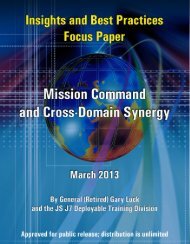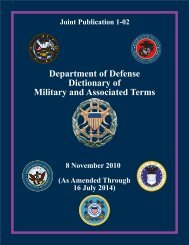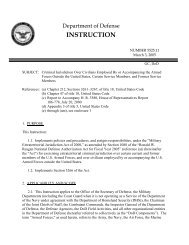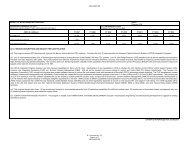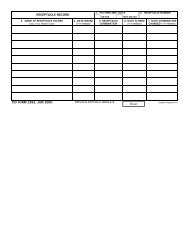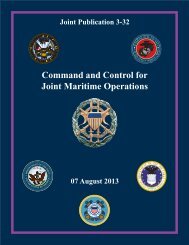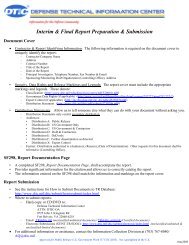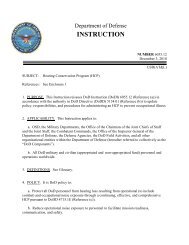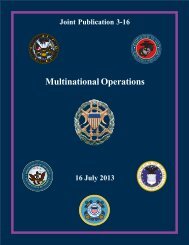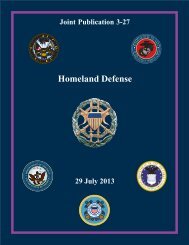JP 1, Doctrine for the Armed Forces of the United States - Defense ...
JP 1, Doctrine for the Armed Forces of the United States - Defense ...
JP 1, Doctrine for the Armed Forces of the United States - Defense ...
Create successful ePaper yourself
Turn your PDF publications into a flip-book with our unique Google optimized e-Paper software.
Theory and Foundations<br />
6. Campaigns and Operations<br />
a. Tactics, techniques, and procedures are <strong>the</strong> fundamental building blocks <strong>of</strong> concrete<br />
military activity. Broadly, actions generate effects; <strong>the</strong>y change in <strong>the</strong> environment or<br />
situation. Tactical actions are <strong>the</strong> component pieces <strong>of</strong> operations.<br />
b. An operation is a sequence <strong>of</strong> tactical actions with a common purpose or unifying<br />
<strong>the</strong>me. An operation may entail <strong>the</strong> process <strong>of</strong> carrying on combat, including movement,<br />
supply, attack, defense, and maneuvers needed to achieve <strong>the</strong> objective <strong>of</strong> any battle or<br />
campaign. However, an operation need not involve combat. A major operation is a series <strong>of</strong><br />
tactical actions, such as battles, engagements, and strikes, conducted by combat <strong>for</strong>ces<br />
coordinated in time and place, to achieve strategic or operational objectives in an operational<br />
area.<br />
c. A campaign is a series <strong>of</strong> related major operations aimed at achieving strategic and<br />
operational objectives within a given time and space. Planning <strong>for</strong> a campaign is appropriate<br />
when contemplated military operations exceed <strong>the</strong> scope <strong>of</strong> a single major operation. Thus,<br />
campaigns are <strong>of</strong>ten <strong>the</strong> most extensive joint operations in terms <strong>of</strong> time and o<strong>the</strong>r resources.<br />
Some operations can be executed in a single operation and not require campaigning. A<br />
noncombatant evacuation, <strong>for</strong> example, may be executed in a single operation.<br />
7. Task, Function, and Mission<br />
It is worthwhile to discuss three key terms, task, function, and mission, which are<br />
relevant to <strong>the</strong> conduct <strong>of</strong> warfare at all levels.<br />
a. A task is a clearly defined action or activity assigned to an individual or organization.<br />
It is a specific assignment that must be done as it is imposed by an appropriate authority.<br />
Function and mission implicitly involve things to be done, or tasks. It is, however, important<br />
to delineate between an organization’s function and its mission.<br />
b. A function is <strong>the</strong> broad, general, and enduring role <strong>for</strong> which an organization is<br />
designed, equipped, and trained. Organizationally, functions may be expressed as a task, a<br />
series <strong>of</strong> tasks, or in more general terms. Broadly, a function is <strong>the</strong> purpose <strong>for</strong> which an<br />
organization is <strong>for</strong>med. In <strong>the</strong> context <strong>of</strong> employing a joint <strong>for</strong>ce, joint functions are six<br />
basic groups <strong>of</strong> related capabilities and activities—C2, intelligence, fires, movement and<br />
maneuver, protection, and sustainment—that help JFCs integrate, synchronize, and direct<br />
joint operations.<br />
c. Mission entails <strong>the</strong> task, toge<strong>the</strong>r with <strong>the</strong> purpose, that clearly indicates <strong>the</strong> action to<br />
be taken and <strong>the</strong> reason <strong>the</strong>re<strong>for</strong>e. A mission always consists <strong>of</strong> five parts: <strong>the</strong> who<br />
(organization to act), what (<strong>the</strong> task to be accomplished and actions to be taken), when (time<br />
to accomplish <strong>the</strong> task), where (<strong>the</strong> location to accomplish <strong>the</strong> task), and why (<strong>the</strong> purpose<br />
<strong>the</strong> task is to support). Higher headquarters commanders typically assign a mission or tasks<br />
to <strong>the</strong>ir subordinate commanders, who convert <strong>the</strong>se to a specific mission statement through<br />
mission analysis. A mission is what an organization is directed to do. Functions are <strong>the</strong><br />
purposes <strong>for</strong> which an organization is <strong>for</strong>med. The two are symbiotic. Tasks are relevant to<br />
both functions and missions.<br />
I-9



